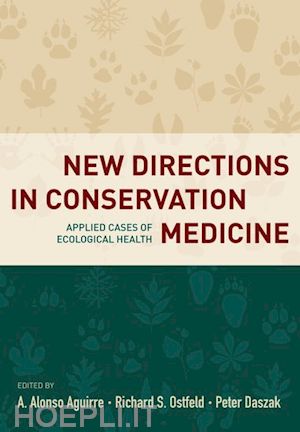Introduction; (A. Alonso Aguirre and Sara E. Howard); Part I: Conservation Medicine: Ecological Health in Practice; 1. Conservation Medicine: Ontogeny of an Emerging Discipline; A. Alonso Aguirre, G.M. Tabor and Richard S. Ostfeld; 2. EcoHealth: Creating a Truly a Global Transdiscipline; Bruce A. Wilcox, Pierre Horwitz, and A. Alonso Aguirre; 3. One Health, One Medicine; Laura H. Kahn, Thomas P. Monath, Bob H. Bokma, Paul Gibbs, A. Alonso Aguirre; 4. Biodiversity and Human Health; Aaron Bernstein; 5. An Ecosystem Service of Biodiversity - The Protection of Human Health Against Infectious Disease; Felicia Keesing and Richard S. Ostfeld; 6. Parasite Conservation, Conservation Medicine and Ecosystem Health; Andres Gomez, Elizabeth Nichols and Susan L. Perkins; 7. Stress and Immunosuppression as Factors in the Decline and Extinction of Populations: The Concepts, the Evidence and the Challenges; Heribert Hofer and Marion L. East; Part II: Anthropogenic Change and Conservation Medicine; 8. Predicted Impacts of Climate on Emerging Diseases: A Model for Global Change; Raina K. Plowright, Paul C. Cross, Gary M. Tabor, Emily Almberg, Leslie Bienen, and Peter Hudson; 9. Wildlife Health in a Changing North: A Model for Global Environmental Change; Morten Tryland, Susan Kutz and Patricia Curry; 10. Habitat Fragmentation and Infectious Disease Ecology; Gerardo Suz?n, Fernando Esponda, Roberto Carrasco-Hern?ndez, A. Alonso Aguirre; 11. Wildlife Trade and the Spread of Disease; Katherine F. Smith, Lisa M. Schloegel, and Gail E. Rosen; 12. Bushmeat and Infectious Disease Emergence; Matthew LeBreton, Brian L. Pike, Karen E. Saylors, Joseph L. Diffo, Joseph N. Fair, Anne W. Rimoin, Nancy Ortiz, Cyrille F. Djoko, Ubald Tamoufe, Nathan D. Wolfe; 13. Human Migration, Border Controls and Infectious Disease Emergence; Anne M. Alexander, David C. Finnoff and Jason F. Shogren; Part III: Emerging Infectious Diseases and Conservation Medicine; 14. Are Bats Exceptional Viral Reservoirs?; Kevin J. Olival, Jonathan H. Epstein, Lin-Fa Wang, Hume E. Field and Peter Daszak; 15. SARS: A Case Study for Factors Driving Disease Emergence; Wolfgang Preiser; 16. H5N1 Highly Pathogenic Avian Influenza: Breaking the Rules in Disease Emergence; Thijs Kuiken and Timm Harder; 17. Bartonellosis: An Emerging Disease of Humans, Domestic Animals and Wildlife; Ricardo G. Maggi, Craig A. Harms, Edward B. Breitschwerdt; 18. Brucella ceti and Brucella pinnipedialis Infections in Marine Mammals; Jacques Godfroid, Ingebj?rg Nymo, Morten Tryland, Axel Cloeckaert, Thierry Jauniaux, Adrian M. Whatmore, Edgardo Moreno, Geoffrey Foster; 19. Infectious Cancers in Wildlife; Hamish McCallum and Menna Jones; 20. From Protozoan Infection in Monarch Butterflies to Colony Collapse Disorder in Bees: Are Emerging Infectious Diseases Proliferating in the Invertebrate World?; Rebecca Bartel and Sonia Altizer; 21. Fungal Diseases in Neotropical Forests Disturbed by Humans; Julieta Benitez-Malvido; 22. Emerging Infectious Diseases in Fisheries and Aquaculture; E. Scott Weber; 23. Southern Sea Otters: Sentinels of Land-Sea Pathogens and Pollutants; David A. Jessup and Melissa A. Miller; Part IV: Ecotoxicology and Conservation Medicine; 24. Ecotoxicology: Bridging Wildlife, Humans and Ecosystems; Jeffrey M. Levengood and Val R. Beasley; 25. Wildlife Toxicology: Environmental Contaminants and their National and International Regulation; K. Christiana Grim, Anne Fairbrother, Barnett A. Rattner; 26. Marine Biotoxins: Emergence of Harmful Algal Blooms as Health Threats to Marine Wildlife; Spencer E. Fire, Frances M. Van Dolah; 27. Beluga from the St Lawrence Estuary: A Case Study of Cancer and Polycyclic Aromatic Hydrocarbons; Daniel Martineau; Part V: Place Based Conservation Medicine; 28. Sense and Serendipity: Conservation and Management of Bison in Canada; Margo J. Pybus and Todd K. Shury; 29. Pathogens, Parks and People: The Role of Bovine Tuberculosis in South African Conservation; Claire Geoghegan; 30. Disease Ecology and Conservation of Ungulates, Wild Rabbits and the Iberian Lynx in the Mediterranean Forest; Fernando Martinez, Guillermo Lopez and Christian Gortazar; 31. The Kibale EcoHealth Project: Exploring the Connections among Human Health, Animal Health, and Landscape Dynamics in Western Uganda; Tony L. Goldberg, Sarah B. Paige and Colin A. Chapman; 32. Conservation Medicine in Brazil: Case Studies of Ecological Health in Practice; Paulo Rogerio Mangini, Rodrigo Silva Pinto Jorge, Marcelo Renan de Deus Santos, Alessandra Nava, Carlos Eduardo da Silva Verona, Maria Fernanda Vianna Marvulo, Jean Carlos Ramos Silva; 33. Linking Conservation of Biodiversity and Culture with Sustainable Health and Wellness: The Itzama Model and Global Implications for Healing Across Cultures; Todd J. Pesek, Victor Cal, Kevin Knight, John Arnason; 34. Biodiversity and Human Health: Using Plants and Traditional Ethnomedical Knowledge to Improve Public Health and Conservation Programs in Micronesia; Michael J. Balick, Katherine Herrera, Francisca Sohl, Wayne Law, Roberta Lee and William C. Raynor; Part VI: Applied techniques Of Conservation Medicine; 35. Human Health in the Biodiversity Hotspots: Applications of Geographic Information System Technology and Implications for Conservation; Larry J. Gorenflo; 36. Determining when Parasites of Amphibians are Conservation Threats to their Hosts: Methods and Perspectives; Trent W. J. Garner, Cheryl J. Briggs, Jon Bielby and Matthew C. Fisher; 37. Strategies for Wildlife Disease Surveillance; Jonathan M. Sleeman, Christopher J. Brand, Scott D. Wright; 38. Wildlife Health Monitoring in North America: From Sentinel Species to Public Policy; Michelle M. Willette, Julia B. Ponder, Dave L. McRuer, Edward E. Clark, Jr.; 39. The Establishment of Serum Banks for Eco-Epidemiological Investigations of Infectious Diseases in Marine Mammals; A. Alonso Aguirre, Melinda K. Rostal, Thomas J. Keefe; 40. Sorta Situ: The New Reality of Management Conditions for Wildlife Populations in the Absence of 'Wild' Spaces; Barbara A. Wolfe, Roberto F. Aguilar, A. Alonso Aguirre, Glenn H. Olsen, Evan S. Blumer; 41. Modeling Population Viability and Extinction Risk in the Presence of Parasitism; Patrick Foley and Janet E. Foley; 42. Using Mathematical Models in a Unified Approach to Predicting the Next Emerging Infectious Disease; Tiffany L. Bogich, Kevin J. Olival, Parviez R. Hosseini, Sebastian Funk, Ilana L. Brito, Jonathan H. Epstein, John S. Brownstein, Damien O. Joly, Marc A. Levy, Kate E. Jones, Stephen S. Morse, A. Alonso Aguirre, William B. Karesh, Jonna AK Mazet, and Peter Daszak; Index











